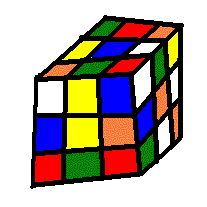
My speedcubing page |
|
This is my speedcubing page. You'll find here all about my method, my cube ideas and so on. I think this page is going to be the coolest page on this whole site. Anyway here are (some of) the most original ideas of mine. Enjoy! |
|
My method |
|
The method I use is a slightly modified Lars Petrus method, the difference being explained below. I have tried Jessica Fridrich's method too and I think the first two layers were easier to do, but I'm keeping on Lars's method! I just want to prove that one can get really fast with other method than Jessica's. When I saw that almost all the top cubists are using the same system, different from mine, I said, let's show them who's a top cubist with another method! For that though I have to be about 3 times faster :( I first had the idea of this method when I noticed that whatever move sequence using just two (adjacent) sides I applied, it didn't alter the permutation of the corners on the last layer. In other words, all the move sequences used for the last layer that used two faces were used only for orienting the corners and permuting the edges (it's easy to see that the edges are not twisted by moving only two sides). So I said, what if we could fix this thing before finishing the last layer? Not only would it be cooler, but it should take fewer moves (since you do it when you can scramble more of the cube: not only one side, but two of them). However, there was one problem: if you move only two sides you don't change the corners' permutation, so you have to move another third side, and that would mean altering the edges' orientation. The solution is easy to see: you orient the edges and permute the corners at the same time. I found some algorithms for doing that and they are shorter than the third layer corner permutation algorithms in Lars's method. You also solve bad edges at the same time! A full description of the method together with algorithms is on my method page. I said earlier on this page that I observed that the corners' permutation did not change. Well, now (two months later) I found a mathematical demonstration for this. This demonstration is (I think) the only one until now, of course excepting the demonstrations that searched through every possible position with the help of computers. I'm so glad!!! |
|
Ideas |
|
First idea after the idea of my method was, of course, the idea of solving the whole cube turning only two sides (naturally after solving the rest), but I didn't work much on it. It's easier to solve the cube by using for instance only algorithms consisting of two sides than by turning two fixed sides. It's more natural, otherwise you're forced to "bring" the alg to the grip, not the grip to the alg. And you don't make additional moves that take time. One more reason for the anti-idea of this paragraph is (take a breath!) that Lars Petrus on his step 6-7 index page gives many move sequences consisting of (usually two) algorithms that turn two sides only, the small algorithms using each two sides but the big algorithm not, and I'm learning the algorithms from this page. That's quite all with the two-sided idea... Not quite all, I now (2 months later) think that it's easier to bring the alg to the grip, since turning a face takes less time than turning the whole cube. :) |
|
Media |
|
Media means (for the moment) videos. I hope I will be able to make videos with other subjects than a speedsolve. But maybe I won't have enough space (I can use up to 15 MB), and that solves the problem. |
|
Links |
|
| Lars Petrus | Where I learnt to solve the cube. The method is both excellent and excellently explained. |
| Cubestation | Dan Harris's website. Hosts the Fewest Moves Challenge. This is the first site that put a link to my page! |
| Charlie Tsai's web page | Charlie uses the same method as me for FMC, but he knows more (and shorter) algorithms than I know, and also he is much more experienced. |
| Home | |